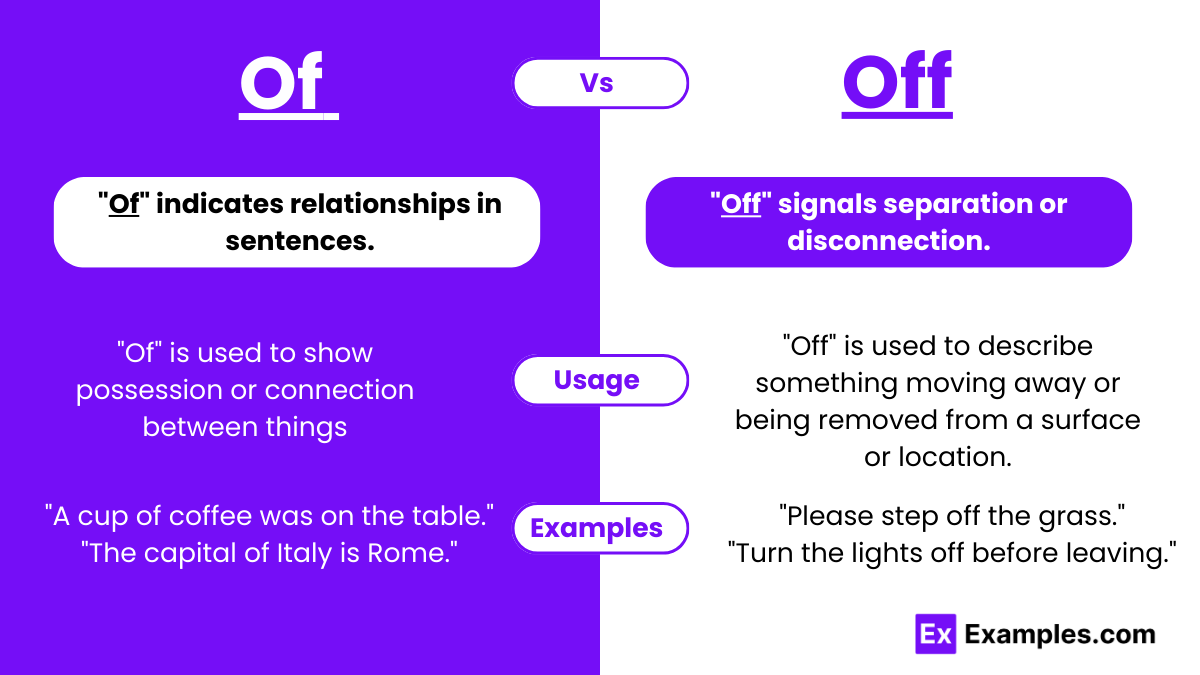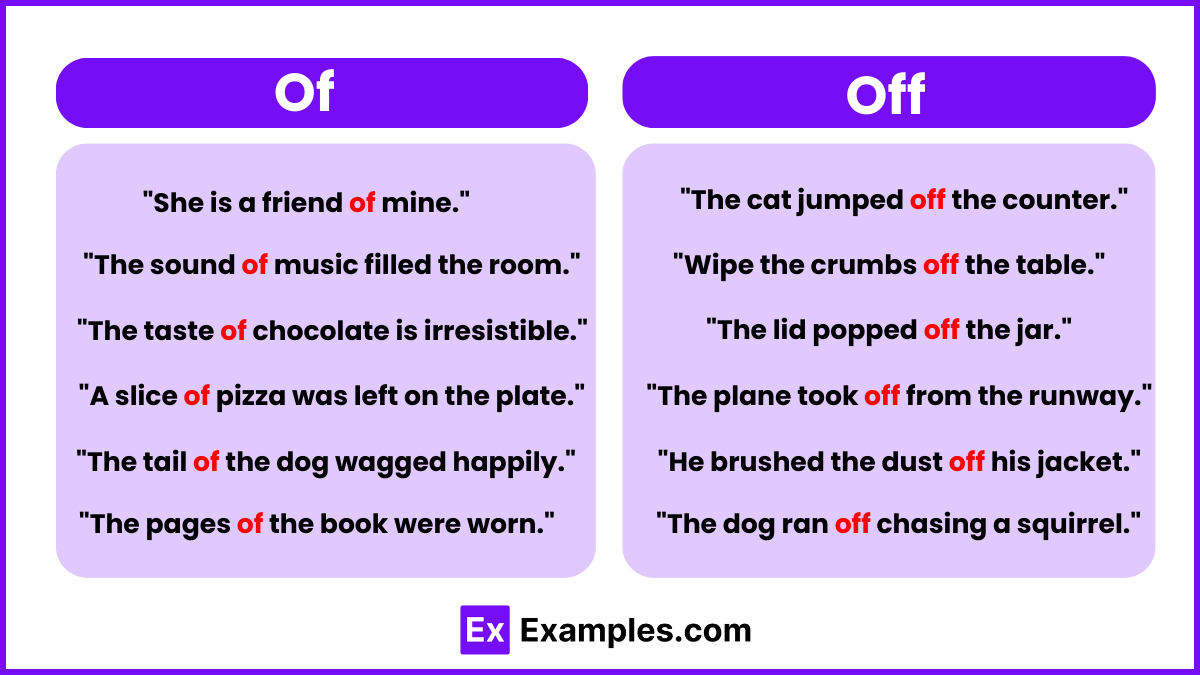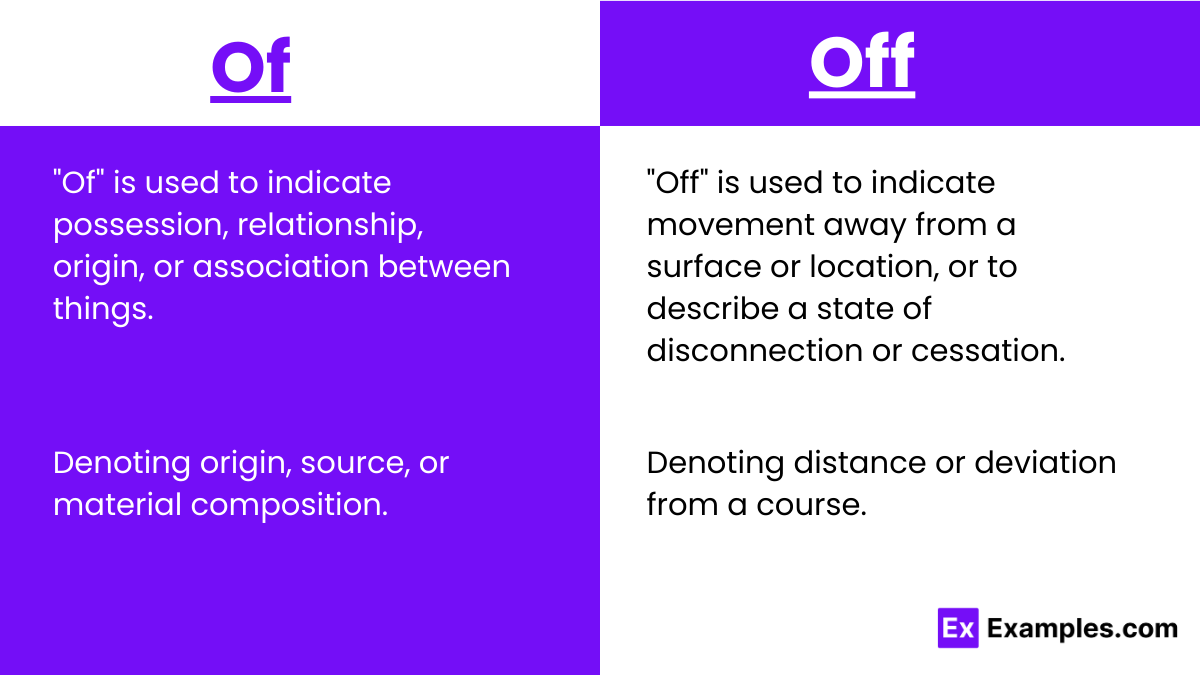Of vs Off – Examples, Differences, Usage, Tips
The English language, where every thread has its place and purpose, the words “of” and “off” emerge as two strands that often entangle students in a web of confusion. Despite their similar appearance and pronunciation, these terms carry fundamentally different meanings and serve unique functions within the fabric of a sentence. “Of” acts as a preposition, weaving connections that denote relationships of possession, composition, inclusion, or origin, subtly binding elements of a sentence to convey a sense of belonging or derivation. It is the glue that holds disparate elements together, suggesting a connection or relation that enriches the narrative or argument being constructed.
On the flip side, “off” functions dually as a preposition and an adverb, each role casting a light on notions of separation, disconnection, or departure. Whether indicating a physical distancing, as in moving away from a point of reference, or a figurative detachment from a previous state or condition, “off” encapsulates a break in continuity that is essential for certain expressions and contexts. This distinction becomes pivotal in crafting sentences that are not only grammatically correct but also rich in meaning and clarity. Understanding the nuanced roles of “of” and “off” empowers students to navigate the complexities of English with greater confidence and precision, turning potential pitfalls into opportunities for linguistic sophistication.
Of and Off – Meanings
Of: “Of” is a preposition that plays a crucial role in indicating relationships between elements within a sentence. It is used to express various connections such as possession, origin, composition, and association. For instance, in “the color of the sky,” “of” shows the relationship between the sky and its color, denoting what the sky possesses. In “a piece of cake,” it signifies a part belonging to a larger whole, illustrating the concept of composition. “Of” serves to create a link that brings clarity and specificity to descriptions and relationships in language.
Off: “Off,” on the other hand, functions both as an adverb and a preposition, primarily signaling disconnection or separation. As an adverb, “off” indicates movement away from a previous position, such as in “the hat fell off.” When used as a preposition, it denotes detachment or a point of departure, exemplified by “off the table,” suggesting something is no longer in contact with the table. “Off” embodies the idea of moving away from or losing attachment to something, highlighting a physical or metaphorical distancing in various contexts.
Summary
The terms “of” and “off” serve distinct functions in English, despite their frequent usage and phonetic similarity. “Of” primarily acts as a preposition, delineating connections such as affiliation, possession, constituent materials, or quantities among elements. Conversely, “off” exhibits versatility as a preposition, adverb, adjective, or verb, signifying departure, severance, elimination, or a state of inactivity. These words, integral to constructing precise and nuanced sentences, encapsulate a broad spectrum of meanings from relational bonds to actions of separation or cessation.
Difference Between Of and Off
In the intricate tapestry of the English language, “of” and “off” stand out as two terms that, despite their similar spelling and pronunciation, carry distinct meanings and serve different grammatical functions. “Of” is predominantly used as a preposition that denotes relationships, such as belonging, origin, or composition, weaving a web of connections between words and enhancing the clarity of descriptions. “Off,” in contrast, exhibits greater versatility, acting as a preposition, adverb, adjective, or verb, and is commonly associated with separation, disconnection, or cessation. These differences are crucial for effective communication, as they help to convey precise meanings and intentions. The following table highlights ten key distinctions between “of” and “off” to guide proper usage.
| Aspect | Of | Off |
|---|---|---|
| Primary Function | Preposition | Can function as a preposition, adverb, adjective, or verb |
| Common Usage | Indicates relationships, belonging, or origin | Indicates separation, distance, or the act of turning something inactive |
| Examples | “A piece of cake”, “The sound of music” | “Turn off the light”, “Walked off the stage” |
| Association | With things that are part of a whole, origin, or description | With movement away from something, disconnection, or deactivation |
| In Sentences | “The title of the book”, “The edge of the table” | “Jump off the cliff”, “The show is off tonight” |
| Phonetic Similarity | Often confused with “off” due to similar spelling | Sounds similar to “of”, leading to common mix-ups |
| As a Preposition | Shows relation or possession | Denotes separation or removal |
| As an Adverb | Not applicable | Describes an action moving away from a place or position |
| As an Adjective | Not applicable | Describes something that is not active or in operation |
| As a Verb | Not applicable | Used to indicate the action of removing or distancing |
Examples of Of and Off
Here are examples to illustrate the specific usages of “of” and “off,” providing clarity on when and how to use each term effectively.
Examples of “Of”
- The taste of the cake was exquisite.
- She is the CEO of a multinational corporation.
- A flock of birds flew over the lake at sunset.
- He drank a cup of coffee to start his day.
- The pages of the book had turned yellow with age.
Examples of “Off”
- Please turn off the lights before leaving.
- The cat jumped off the windowsill.
- He took Monday off to extend his weekend.
- The paint is peeling off the walls.
- She lives just off the main road.
When to Use Of and Off
Understanding when to use “of” and “off” is crucial for clear and precise communication in English.
Use “Of” when:
- Indicating relationships or connections between things, such as possession, belonging, or association. Example: “The color of the sky.”
- Referring to components or parts that make up a whole. Example: “A piece of pie.”
- Denoting origin, source, or material composition. Example: “A man of integrity.”
- Expressing measurements or quantities. Example: “A cup of tea.”
Use “Off” when:
- Indicating movement away from a place or position. Example: “He walked off the stage.”
- Describing the cessation of operation or activity. Example: “Turn off the lights.”
- Referring to the removal or separation from something. Example: “He shaved off his beard.”
- Denoting distance or deviation from a course. Example: “The island is off the coast.”
Tips for Of and Off
Navigating the use of “of” and “off” can be tricky due to their similar spelling but distinct meanings. Here are some tips to help distinguish between the two:
- Context Is Key: “Of” typically indicates a relationship or belonging, while “off” suggests separation or distance. Consider the relationship you wish to express.
- Check for Ownership or Association: If the sentence involves a sense of belonging, composition, or relation, “of” is likely the correct choice. Example: “The lid of the jar.”
- Look for Action or Distance: If the sentence implies movement away from a surface, a point in time, or turning something inactive, “off” is probably the right word. Example: “Jump off the pier.”
- “Of” for Components: Use “of” when talking about parts of a whole or contents within something. Example: “A bottle of water.”
- “Off” for Disconnection: Use “off” when indicating disconnection or removal. Example: “Take your feet off the table.”
- Prepositional Use: Remember, “of” is used as a preposition to connect nouns, showing possession, origin, or what something consists of. “Off” can be a preposition but often indicates separation.
- Adverbial “Off”: When “off” is used as an adverb, it often describes an action moving away or ceasing. Example: “The show is off.”
- Double-check with Replacement: Try replacing “of” with “belonging to” or “coming from” and “off” with “away from” or “not on.” If the sentence still makes sense, you’ve likely used the right word.
- Practice with Examples: Regularly practice writing sentences using both “of” and “off” to build your intuition for their correct usage.
- Proofread: Always proofread your writing to catch any instances where “of” and “off” might have been confused, ensuring your message is clear and accurate.
FAQs
Is Off a Verb or Not?
“Off” can function as an adverb, preposition, or adjective, but not typically as a verb. It’s used to indicate movement away from a place, the deactivation of a device, or a state of inactivity.
What Does Off Mean After a Verb?
When “off” follows a verb, it usually acts as an adverb or preposition, suggesting separation, distance, or the cessation of an action. For example, “take off” implies removing something, while “switch off” means to deactivate.
Is It Correct to Use Off Of?
While “off of” is commonly used in informal speech, it’s often considered redundant in formal writing. “Off” by itself usually suffices to convey the meaning of separation or distance from something.





